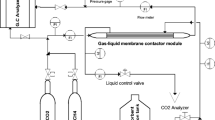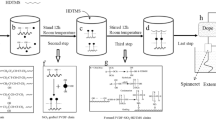Abstract
In this study, tri-ethylene glycol (TEG) based nanofluids of carbon nanotubes (CNT), silica (SiO2) and aluminum oxide (Al2O3) in different weight percents of 0.01 and 0.05 wt% were employed to improve the properties of TEG for water vapor absorption in a hollow fiber membrane contactor (HFMC). To do so, the impact of various operational parameters including nanofluid type, nanoparticles (NPs) concentration, liquid and gas flow rate on water vapor separation were elucidated. According to obtained results, CNT nanofluid was more capable on water vapor absorption toward SiO2 and Al2O3, so that the injection of CNT nanofluid led to water vapor absorption enhancement up to 10.8 % as compared to TEG solution alone. The results also indicated that the gas flow rate has an inverse relationship with the amount of water vapor absorption efficiency, whereas increasing the liquid flow rate has no tangible effect on absorption efficiency, which is because of the very high solubility of water vapor in TEG. Ultimately, dynamic light scattering (DLS) analysis was carried out to evaluate the stability of nanofluids and size distribution of nanostructures in the base fluid.











Similar content being viewed by others
Data Availability
All data generated or analysed during this study are included in this published article (and its supplementary information files).
Abbreviations
- Am :
-
Gas-liquid mass transfer area (m2)
- Cin :
-
Inlet water vapor concentration (mol.m-3)
- Cout :
-
Outlet water vapor concentration (mol.m-3)
- J:
-
Water vapor absorption flux (mol.m-2.s-1)
- Qin :
-
Inlet air flow rate (m3.s-1)
- Qout :
-
Out air flow rate (m3.s-1)
- Re:
-
Reynolds number (dimensionless)
- η:
-
Water vapor removal efficiency
- Al2O3 :
-
Aluminum oxide
- CNT:
-
Carbon nanotube
- DLS:
-
Dynamic Light Scattering
- HFMC:
-
Hollow fiber membrane contactors
- I.D:
-
Inner diameter (mm)
- LiBr:
-
Lithium bromide
- MWCNT-COOH:
-
Carboxy multi-walled carbon nanotubes
- NPs:
-
Nanoparticles
- O.D:
-
Outer diameter (mm)
- PP:
-
Polypropylene
- SiO2 :
-
Silicon dioxide
- SSA:
-
Specific surface area (m2.g-1)
- TEG:
-
Tri-ethylene glycol
References
Mokhatab S, Poe WA, Mak JY (2018) Handbook of natural gas transmission and processing: principles and practices. Gulf Professional Publishing, Oxford
Stewart M, Arnold K (2011) Gas dehydration field manual. Gulf Professional Publishing, Oxford
Bergero S, Chiari A (2001) Experimental and theoretical analysis of air humidification/dehumidification processes using hydrophobic capillary contactors. Appl Therm Eng 21(11):1119–1135
Chung T-W, Wu H (2000) Comparison between spray towers with and without fin coils for air dehumidification using triethylene glycol solutions and development of the mass-transfer correlations. Ind Eng Chem Res 39(6):2076–2084
Fakharnezhad A, Masoumi S, Keshavarz P (2019) Analysis of design parameter effects on gas dehumidification in hollow fiber membrane contactor: Theoretical and experimental study. Sep Purif Technol 226:22–30
Kinsara AA, Elsayed MM, Al-Rabghi OM (1996) Proposed energy-efficient air-conditioning system using liquid desiccant. Appl Therm Eng 16(10):791–806
Factor HM, Grossman G (1980) A packed bed dehumidifier/regenerator for solar air conditioning with liquid desiccants. Sol Energy 24(6):541–550
Grossman G, Johannsen A (1981) Solar cooling and air conditioning. Prog Energy Combust Sci 7(3):185–228
Johannsen A (1984) Performance simulation of a solar air-conditioning system with liquid desiccant. Int J Ambient Energy 5(2):59–88
Robison H, Houston S (1980) Absorption/desorption solar cooling system performance. Fundamentals and applications of solar energy. In: AICHE Symp Ser, pp 139–143
Babakhani D, Soleymani M (2009) An analytical solution for air dehumidification by liquid desiccant in a packed column. Int Commun Heat Mass Transfer 36(9):969–977
Chung T-W (1994) Predictions of moisture removal efficiencies for packed-bed dehumidification systems. Gas Sep Purif 8(4):265–268
Chung T-W, Ghosh TK, Hines AL (1993) Dehumidification of air by aqueous lithium chloride in a packed column. Sep Sci Technol 28(1–3):533–550
Oberg V, Goswami DY (1998) Experimental study of the heat and mass transfer in a packed bed liquid desiccant air dehumidifier. J Sol Energy Eng 120(4):289–297
Wang R, Zhang H, Feron P, Liang D (2005) Influence of membrane wetting on CO2 capture in microporous hollow fiber membrane contactors. Sep Purif Technol 46(1–2):33–40
Zurigat Y, Abu-Arabi M, Abdul-Wahab S (2004) Air dehumidification by triethylene glycol desiccant in a packed column. Energy Convers Manag 45(1):141–155
Fakharnezhad A, Keshavarz P (2016) Experimental investigation of gas dehumidification by tri-ethylene glycol in hollow fiber membrane contactors. J Ind Eng Chem 34:390–396
Gabelman A, Hwang S-T (1999) Hollow fiber membrane contactors. J Membr Sci 159(1–2):61–106
Li J-L, Chen B-H (2005) Review of CO2 absorption using chemical solvents in hollow fiber membrane contactors. Sep Purif Technol 41(2):109–122
Keshavarz P, Fathikalajahi J, Ayatollahi S (2008) Analysis of CO2 separation and simulation of a partially wetted hollow fiber membrane contactor. J Hazard Mater 152(3):1237–1247
Zhang L-Z, Huang S-M, Chi J-H, Pei L-X (2012) Conjugate heat and mass transfer in a hollow fiber membrane module for liquid desiccant air dehumidification: a free surface model approach. Int J Heat Mass Transf 55(13–14):3789–3799
Al-Marzouqi MH, El-Naas MH, Marzouk SA, Al-Zarooni MA, Abdullatif N, Faiz R (2008) Modeling of CO2 absorption in membrane contactors. Sep Purif Technol 59(3):286–293
Boributh S, Assabumrungrat S, Laosiripojana N, Jiraratananon R (2011) Effect of membrane module arrangement of gas–liquid membrane contacting process on CO2 absorption performance: A modeling study. J Membr Sci 372(1–2):75–86
Qi Z, Cussler E (1985) Microporous hollow fibers for gas absorption: I. Mass transfer in the liquid. J Membr Sci 23(3):321–332
Qi Z, Cussler E (1985) Microporous hollow fibers for gas absorption: II. Mass transfer across the membrane. J Membr Sci 23(3):333–345
Isetti C, Nannei E, Magrini A (1997) On the application of a membrane air—liquid contactor for air dehumidification. Energy Build 25(3):185–193
Chiari A (2000) Air humidification with membrane contactors: experimental and theoretical results. Int J Ambient Energy 21(4):187–195
Elhambakhsh A, Keshavarz P (2020) Investigation of carbon dioxide absorption using different functionalized Fe3O4 magnetic nanoparticles. Energy Fuels 34(6):7198–7208
Elhambakhsh A, Zaeri MR, Mehdipour M, Keshavarz P (2020) Synthesis of different modified magnetic nanoparticles for selective physical/chemical absorption of CO2 in a bubble column reactor. J Environ Chem Eng :104195. https://doi.org/10.1016/j.jece.2020.104195
Lee JW, Pineda IT, Lee JH, Kang YT (2016) Combined CO2 absorption/regeneration performance enhancement by using nanoabsorbents. Appl Energy 178:164–176
Golkhar A, Keshavarz P, Mowla D (2013) Investigation of CO2 removal by silica and CNT nanofluids in microporous hollow fiber membrane contactors. J Membr Sci 433:17–24. https://doi.org/10.1016/j.memsci.2013.01.022
Chol S, Estman J (1995) Enhancing thermal conductivity of fluids with nanoparticles. ASME-Publications-Fed 231:99–106
Das SK, Putra N, Thiesen P, Roetzel W (2003) Temperature dependence of thermal conductivity enhancement for nanofluids. J Heat Transf 125(4):567–574
Eastman JA, Choi S, Li S, Yu W, Thompson L (2001) Anomalously increased effective thermal conductivities of ethylene glycol-based nanofluids containing copper nanoparticles. Appl Phys Lett 78(6):718–720
Kang YT, Kim HJ, Lee KI (2008) Heat and mass transfer enhancement of binary nanofluids for H2O/LiBr falling film absorption process. Int J Refrig 31(5):850–856
Rahmatmand B, Keshavarz P, Ayatollahi S (2016) Study of absorption enhancement of CO2 by SiO2, Al2O3, CNT, and Fe3O4 nanoparticles in water and amine solutions. J Chem Eng Data 61(4):1378–1387
Zare P, Keshavarz P, Mowla D (2019) Membrane absorption coupling process for CO2 capture: application of water-based ZnO, TiO2, and multi-walled carbon nanotube nanofluids. Energy Fuels 33(2):1392–1403
Krishnamurthy S, Bhattacharya P, Phelan P, Prasher R (2006) Enhanced mass transport in nanofluids. Nano Lett 6(3):419–423. https://doi.org/10.1021/nl0522532
Lu S, Xing M, Sun Y, Dong X (2013) Experimental and theoretical studies of CO2 absorption enhancement by nano-Al2O3 and carbon nanotube particles. Chin J Chem Eng 21(9):983–990
Pang C, Lee JW, Kang YT (2015) Review on combined heat and mass transfer characteristics in nanofluids. Int J Therm Sci 87:49–67
Peyravi A, Keshavarz P, Mowla D (2015) Experimental investigation on the absorption enhancement of CO2 by various nanofluids in hollow fiber membrane contactors. Energy Fuels 29(12):8135–8142
Alper E, Wichtendahl B, Deckwer W-D (1980) Gas absorption mechanism in catalytic slurry reactors. Chem Eng Sci 35(1–2):217–222
Kars R, Best R, Drinkenburg A (1979) The sorption of propane in slurries of active carbon in water. Chem Eng J 17(3):201–210
Kim H, Jeong J, Kang YT (2012) Heat and mass transfer enhancement for falling film absorption process by SiO2 binary nanofluids. Int J Refrig 35(3):645–651
Ghadimi A, Saidur R, Metselaar H (2011) A review of nanofluid stability properties and characterization in stationary conditions. Int J Heat Mass Transf 54(17–18):4051–4068
Smith B, Wepasnick K, Schrote K, Bertele A, Ball WP, O’Melia C, Fairbrother DH (2008) Colloidal properties of aqueous suspensions of acid-treated, multi-walled carbon nanotubes. Environ Sci Technol 43(3):819–825
Kline SJ (1953) Describing uncertainty in single sample experiments. Mech Eng 75:3–8
Zhang Z, Zhang W, Chen X, Xia Q, Li Z (2010) Adsorption of CO2 on zeolite 13X and activated carbon with higher surface area. Sep Sci Technol 45(5):710–719
Elhambakhsh A, Keshavarz P (2021) Enhanced CO2 capture efficiency applying amine-based nano magnetite/sulfinol-M nano solvents at high pressures. Environ Sci Pollut Res 28(3):3455–3464. https://doi.org/10.1007/s11356-020-10756-6
Elhambakhsh A, Keshavarz P (2020) Effects of different amin-based core-shell magnetic NPs on CO2 capture using NMP solution at high pressures. J Nat Gas Sci Eng 84:103645
Funding
This work was financially supported by Shiraz University, Shiraz, Iran (No. 7134851154).
Author information
Authors and Affiliations
Contributions
Hamed Shadanfar: Data curation, Formal analysis, Investigation and Resources.
Abbas Elhambakhsh: Methodology, Software, Validation, and Writing - original draft.
Peyman Keshavarz: Conceptualization, Visualization, Supervision, Project administration, Funding acquisition and Writing - review & editing.
Corresponding author
Ethics declarations
Ethical approval
Not applicable.
Consent to participate
Not applicable.
Consent to publish
Not applicable.
Conflict of interest
The authors declare that they have no competing interests.
Additional information
Publisher’s note
Springer Nature remains neutral with regard to jurisdictional claims in published maps and institutional affiliations.
Rights and permissions
About this article
Cite this article
Shadanfar, H., Elhambakhsh, A. & Keshavarz, P. Air dehumidification using various TEG based nano solvents in hollow fiber membrane contactors. Heat Mass Transfer 57, 1623–1631 (2021). https://doi.org/10.1007/s00231-021-03057-2
Received:
Accepted:
Published:
Issue Date:
DOI: https://doi.org/10.1007/s00231-021-03057-2




